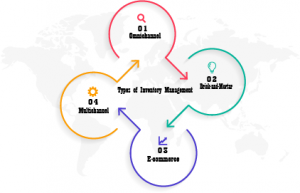When starting a business, any business holder should realize the importance of inventory management. Inventory management is the crucial point of a perfect retail enterprise. Having an incorrect number of items is impossible for any business. If you do not know the amount of your on-hand inventory, it becomes challenging to make the right decisions. For example, you cannot make online listings, as you are not sure how much stock can be present on each of your channels. In the following article, we’ll look to the basics of inventory management in retail, primarily through finding out what inventory management is & inventory management types.

What is Inventory Management?
The central part of your budget will go to the stocking processes. So, it would be best if you kept the balance in your inventory and stock lifecycle: inventory management system, your costs, quality control and customer satisfaction. And first of all, you should correctly understand the inventory management definition.
Inventory Management is one of the supply chain steps in which you keep track of the quantities of your inventory and stock both inside and outside the warehouses. The basics of inventory management systems aim to know exactly where, when and how many lists you have. It is also about the ways you keep control of your inventory, how it is being bought, stored and how it reaches the buyer.
If summarizing all the features of inventory management, we would say that it combines the followings:
- Order management
- Inventory tracking and locating
- Communications with the supplier
- Repair requests automation
- Costs optimization
- Loss and theft prevention
Inventory Management Importance
Having wise and right inventory management, everything the rest connected to your supply chain will get in its place. Some fatal mistakes, like wrong item pick and shipment (mis-pick and mis-shipment), getting out of stocks, having overloaded stores and others, can take place without this process. Let’s try to understand the connection between the use of multichannel inventory management and the consequences.
- Wrong item pick (mis-pick) can be the result of messy warehouses: mainly, poorly organized labels, lists and shelves.
- Wrong shipped items (mis-shipment) can be the direct result of mis-pick; both are the results of low-quality control.
- Overstock and out of stock situations take place when using manual order management. When having a small-size business, it is much easier to keep track and do everything manually. But with the growth of business automation becomes necessary. Keep going, and we’ll talk about this later.
All the negative consequences show that the primary source is the management organization. The wiser you are, the less your problems become. The more your mistakes, the less your customer loyalty and trust becomes.

What is Inventory?
The term that is used in the retail business to define goods and products your company deals with to sell is called inventory. Inventory can include raw materials, product bulks and even software or services.
Types of Inventory
We can define the following main types of stock:
- Raw materials: the materials used by the manufacturer for making your products
- Unfinished goods: products that are on the half-way
- Finished goods: ready products that the buyers buy
- Transit goods: inventory that is on the way of supply chain
- Safety Stock: additional inventory in case suppliers’ run-out
Types of Inventory Management
Inventory management is a powerful tool, but you should also use it correctly. Of course, setting it up will take some additional time, efforts, and money, but it’s worth it. And if you want to be competitive, inventory management is crucial in any business.
Speaking of the types, let’s quickly go through the vital business types.
- E-commerce (online),
- Brick-and-mortar (offline),
- Multichannel
- Omnichannel.
As for the basic inventory management, there are different inventory management techniques for stock level, as well as inventory movement trackings. Businesses that are of smaller size can use Excel or other similar software, but those methods are useful only at the beginning. Sooner or later, you come to the automated ones. One of the most popular and valuable ways is the cloud-based inventory management system. Now we’ll take a look at the types of inventory management and standard techniques, as well as speak in more details about cloud-based inventory management.
Inventory management techniques include:
- Just-in-time (JIT) inventory
- ABC inventory analysis
- Dropshipping
- Bulk shipments
- Backordering
- Consignment
- Cross-docking
- Cycle counting
Cloud-based inventory management
As for the cloud-based inventory management system, it is one of the leading approaches used in e-commerce. To use a cloud-based system means that you can access your data wherever and whenever you need it. Inventory management that is organized through web options can grow simultaneously with your business; they will probably never get out-of-fashion or old to use in years.
eSwap, as one of the leading inventory management software based on cloud technologies, is exceptional support for you to try and realize the efficiency of this method. We make sure here on our platform you can find everything you need for your particular type of business. The list of features, channels with the integration opportunities and the resources will give you the full experience of inventory management. Our flexible pricings even give you the chance to use the platform totally for free.







